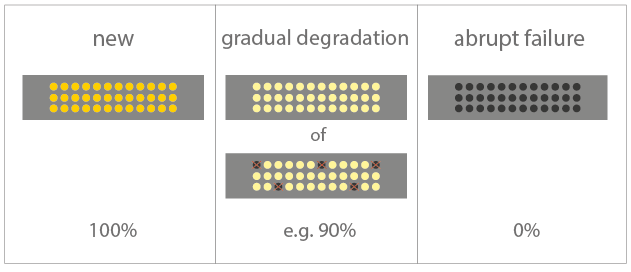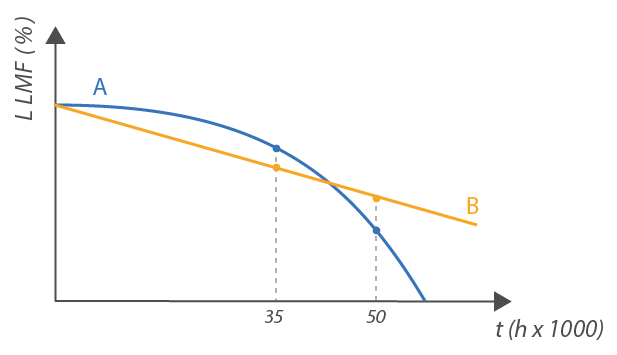Lighting Europe has issued a guidance paper on the subject: 'Evaluating performance of LED based luminaires'. This article sums up the lighting industry’s consensus on the parameters you should find on a quality lighting manufacturer’s datasheet. We provide an overview of these parameters below.
Six initial performance criteria
Lighting Europe recommends comparing the following parameters.
- Rated input power (P in Watt)
- Rated luminous flux (flux Φ in Lumen)
- Rated luminous efficacy (η in Lumen per Watt)
- Rated luminous intensity distribution (in candela or candela per kilolumen)
- Rated correlated colour temperature (CCT in Kelvin)
- Rated colour rendering index (CRI)

Points of special interest
Beware: the published power involves the full power drawn by the luminaire, including the driver or potential external control gear. All too often the power of the LED module is reported and driver losses are not factored in.
Luminous flux and efficiency involve the complete luminaire, and should not be confused with the luminous flux and efficiency of the LED modules. Here too, in practice, optical losses in the secondary optics are not factored in. Furthermore it is important that the luminous flux be provided at the actual operating temperature of the LEDs in the luminaire, and not at a standard 25°C!
For absorbed power, efficiency as well as luminous flux, it is recommended to also explicitly report the matching performance temperature (Tq), even if it is 25°C (standard), as the declared figures all depend on the specific ambient temperature. For deviating temperatures, the values for the provided publication may deviate (just think of recessed fixtures in a ceiling with temperatures reaching 35°C).
Two parameters with respect to lifespan
Quality LED luminaires potentially have a very long service life. During this period, the luminous flux will nonetheless deteriorate to some degree. In order to be able to objectively compare lighting solutions it is recommended to compare the residual luminous flux for the same number of burning hours, instead of comparing duration with assumed light degradation.
The following two factors are important to specify useful life:
- Gradual light output degradation. Useful life is described by a luminaire’s LxBy value. Lighting Europe suggests only using “B50” values, which are median values. The latter are considered to be sufficiently precise for practical calculations, and are furthermore the only values that can be backed by standardised measurements. Here B50 must not be explicitly mentioned and only the Lx value published for an assumed number of burning hours. This is the percentage of the initial luminous flux still delivered on average by a luminaire after the reported number of burning hours. ETAP represents this figure as the LLMF value (Lamp Lumen Maintenance Factor) for a given performance temperature.
- Abrupt failure of the device. The abrupt failure of an LED luminaire can have various reasons: driver failure, LED module failure, poor connections, corrosion, etc. However, few actual data are currently available on the subject and applicable standards are also lacking. Since in practice it has often appeared that for indoor applications, the driver is by far the most critical component, Lighting Europe suggests using the driver’s expected failure percentage today, expressed as Cx whereby x represents the expected failure (in %) during the useful Lx lifespan.

How many burning hours do you really need?
Lighting Europe recommends limiting lifespan estimates to maximum 100,000 burning hours, unless it is explicitly required in highly specific projects and can be backed by more extensive tests. The reliability of lifespan claims quickly becomes inaccurate in any case above 36,000 or 50,000 burning hours, depending on the number of test hours the manufacturers have available. For that matter, it appears from practice that a lifespan of more than 50,000 burning hours is rarely necessary for most indoor applications.
As the required project lifespan and matching number of burning hours may vary considerably between applications, Lighting Europe further suggests specifying the above lifespan (Lx – Cx) factors for different burning hours, e.g., 35,000, 50,000, 75,000 and/or 100,000 hours.

Do you have questions or doubts about the correct reading and interpretation of published data? Please contact us at export@etaplighting.com.
Download the full paper of Lighting Europe
